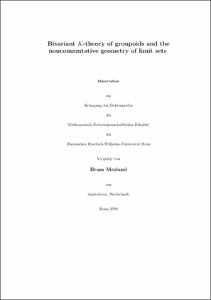Mesland, Bram: Bivariant K-theory of groupoids and the noncommutative geometry of limit sets. - Bonn, 2009. - Dissertation, Rheinische Friedrich-Wilhelms-Universität Bonn.
Online-Ausgabe in bonndoc: https://nbn-resolving.org/urn:nbn:de:hbz:5N-18291
Online-Ausgabe in bonndoc: https://nbn-resolving.org/urn:nbn:de:hbz:5N-18291
@phdthesis{handle:20.500.11811/4109,
urn: https://nbn-resolving.org/urn:nbn:de:hbz:5N-18291,
author = {{Bram Mesland}},
title = {Bivariant K-theory of groupoids and the noncommutative geometry of limit sets},
school = {Rheinische Friedrich-Wilhelms-Universität Bonn},
year = 2009,
month = jul,
note = {We present a categorical setting for noncommutative geometry in the sense of Connes. This is done by introducing a notion of morphism for spectral triples. Spectral triples are the unbounded cycles for $K$-homology (\cite{Con}), and their bivariant generalization are the cycles for Kasparov's $KK$-theory (\cite{Kas}). The central feature of $KK$-theory is the Kasparov product \[KK_{i}(A,B)\otimes KK_{j}(B,C)\rightarrow KK_{i+j}(A,C).\] Here $A,B$ and $C$ are $C^{*}$-algebras, and the product allows one to view $KK$ as a category. The unbounded picture of this theory was introduced by Baaj and Julg (\cite{BJ}). In this picture the external product \[KK_{i}(A,B)\otimes KK_{j}(A',B')\rightarrow KK_{i+j}(A\minotimes B,A'\minotimes B'),\] is given by an algebraic formula, as opposed to Kasparov's original approach, which is more analytic in nature, and highly technical.
In order to describe the internal Kasparov product of unbounded $KK$-cycles, we introduce a notion of connection for unbounded cycles $(\mathpzc{E},D)$. This is a universal connection \[\nabla:\mathpzc{E}\rightarrow\mathpzc{E}\tildeotimes_{B}\Omega^{1}(B),\] in the sense of Cuntz and Quillen (\cite{CQ}), such that $[\nabla,D]$ extends to a completely bounded operator. The topological tensor product used here is the Haagerup tensor product for operator spaces. Blecher (\cite{Blech}) showed this tensor product coincides with the $C^{*}$-module tensor product, in case both operator spaces are $C^{*}$-modules. His work plays a crucial role in our construction. The product of two cycles with connection is given by an algebraic formula and the product of connections can also be defined. Thus, cycles with connection form a category, and the bounded transform \[(\mathpzc{E},D,\nabla)\mapsto(\mathpzc{E},D(1+D^{2})^{-\frac{1}{2}}),\] defines a functor from this category to the category $KK$.
We also describe a general construction for obtaining $KK$-cycles from real-valued groupoid cocycles. If $\mathcal{G}$ is a locally compact Hausdorff groupoid with Haar system and $c:\mathcal{G}\rightarrow\R$ a continuous closed cocycle, we show that pointwise multiplication by $c$ in the convolution algebra $C_{c}(\mathcal{G})$, extends to an unbounded regular operator on the completion of $C_{c}(\mathcal{G})$ as a $C^{*}$-module over $C^{*}(\mathcal{H})$, where $\mathcal{H}$ is the kernel of $c$. It gives a $KK$-cycle for $(C^{*}(\mathcal{G}),C^{*}(\mathcal{H}))$. In case the groupoid $\mathcal{H}$ is unimodular with respect to a quasi-invariant measure, or more general, if $C^{*}(\mathcal{H})$ carries a trace, this $KK$-cycle gives rise to an index map $K_{1}(C^{*}(\mathcal{G}))\rightarrow \C$.
This result is general enough to be applied in a wide variety of examples. We use it to obtain the noncommutative torus as a smooth quotient (in the above categorical sense) of the irrational rotation action on the circle. In the last chapter we sketch the promising range of applications the above categorical setting and cocycle construction may have in the noncommutative geometry of limit sets.},
url = {https://hdl.handle.net/20.500.11811/4109}
}
urn: https://nbn-resolving.org/urn:nbn:de:hbz:5N-18291,
author = {{Bram Mesland}},
title = {Bivariant K-theory of groupoids and the noncommutative geometry of limit sets},
school = {Rheinische Friedrich-Wilhelms-Universität Bonn},
year = 2009,
month = jul,
note = {We present a categorical setting for noncommutative geometry in the sense of Connes. This is done by introducing a notion of morphism for spectral triples. Spectral triples are the unbounded cycles for $K$-homology (\cite{Con}), and their bivariant generalization are the cycles for Kasparov's $KK$-theory (\cite{Kas}). The central feature of $KK$-theory is the Kasparov product \[KK_{i}(A,B)\otimes KK_{j}(B,C)\rightarrow KK_{i+j}(A,C).\] Here $A,B$ and $C$ are $C^{*}$-algebras, and the product allows one to view $KK$ as a category. The unbounded picture of this theory was introduced by Baaj and Julg (\cite{BJ}). In this picture the external product \[KK_{i}(A,B)\otimes KK_{j}(A',B')\rightarrow KK_{i+j}(A\minotimes B,A'\minotimes B'),\] is given by an algebraic formula, as opposed to Kasparov's original approach, which is more analytic in nature, and highly technical.
In order to describe the internal Kasparov product of unbounded $KK$-cycles, we introduce a notion of connection for unbounded cycles $(\mathpzc{E},D)$. This is a universal connection \[\nabla:\mathpzc{E}\rightarrow\mathpzc{E}\tildeotimes_{B}\Omega^{1}(B),\] in the sense of Cuntz and Quillen (\cite{CQ}), such that $[\nabla,D]$ extends to a completely bounded operator. The topological tensor product used here is the Haagerup tensor product for operator spaces. Blecher (\cite{Blech}) showed this tensor product coincides with the $C^{*}$-module tensor product, in case both operator spaces are $C^{*}$-modules. His work plays a crucial role in our construction. The product of two cycles with connection is given by an algebraic formula and the product of connections can also be defined. Thus, cycles with connection form a category, and the bounded transform \[(\mathpzc{E},D,\nabla)\mapsto(\mathpzc{E},D(1+D^{2})^{-\frac{1}{2}}),\] defines a functor from this category to the category $KK$.
We also describe a general construction for obtaining $KK$-cycles from real-valued groupoid cocycles. If $\mathcal{G}$ is a locally compact Hausdorff groupoid with Haar system and $c:\mathcal{G}\rightarrow\R$ a continuous closed cocycle, we show that pointwise multiplication by $c$ in the convolution algebra $C_{c}(\mathcal{G})$, extends to an unbounded regular operator on the completion of $C_{c}(\mathcal{G})$ as a $C^{*}$-module over $C^{*}(\mathcal{H})$, where $\mathcal{H}$ is the kernel of $c$. It gives a $KK$-cycle for $(C^{*}(\mathcal{G}),C^{*}(\mathcal{H}))$. In case the groupoid $\mathcal{H}$ is unimodular with respect to a quasi-invariant measure, or more general, if $C^{*}(\mathcal{H})$ carries a trace, this $KK$-cycle gives rise to an index map $K_{1}(C^{*}(\mathcal{G}))\rightarrow \C$.
This result is general enough to be applied in a wide variety of examples. We use it to obtain the noncommutative torus as a smooth quotient (in the above categorical sense) of the irrational rotation action on the circle. In the last chapter we sketch the promising range of applications the above categorical setting and cocycle construction may have in the noncommutative geometry of limit sets.},
url = {https://hdl.handle.net/20.500.11811/4109}
}






